
|
You entered: CME
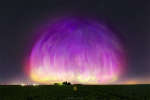 APOD: 2024 May 20 Б Aurora Dome Sky
APOD: 2024 May 20 Б Aurora Dome Sky
19.05.2024
It seemed like night, but part of the sky glowed purple. It was the now famous night of May 10, 2024, when people over much of the world reported beautiful aurora-filled skies. The featured image was captured this night during early morning hours from Arlington, Wisconsin, USA.
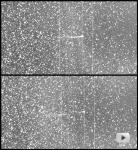 Comet Encke s Tail Ripped off
Comet Encke s Tail Ripped off
3.10.2007
Swinging inside the orbit of Mercury, on April 20th periodic comet Encke encountered a blast from the Sun in the form of a Coronal Mass Ejection (CME). When CMEs, enormous clouds of energetic particles ejected from the Sun, slam into Earth's magnetosphere, they often trigger auroral displays.
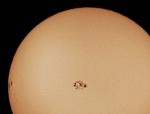 Large Sunspot Groups 10484 and 10486
Large Sunspot Groups 10484 and 10486
26.10.2003
Two unusually large sunspot groups are now crossing the face of the Sun. Each group, roughly the size of Jupiter, is unusual not only for its size but because it is appearing over three years after solar maximum, the peak of solar surface activity.
 APOD: 2024 August 18 Б A Solar Prominence Eruption from SDO
APOD: 2024 August 18 Б A Solar Prominence Eruption from SDO
17.08.2024
One of the most spectacular solar sights is an erupting prominence. In 2011, NASA's Sun-orbiting Solar Dynamic Observatory spacecraft imaged an impressively large prominence erupting from the surface. The dramatic explosion was captured in ultraviolet light in the featured time lapse video covering 90 minutes, where a new frame was taken every 24 seconds.
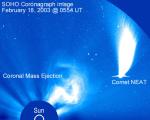 Comet NEAT Passes an Erupting Sun
Comet NEAT Passes an Erupting Sun
23.02.2003
As Comet NEAT flared last week, the Sun roared. Just as the comet swooped inside the orbit of Mercury and developed a long and flowing tail of gas and dust, the Sun emitted a huge Coronal Mass Ejection (CME).
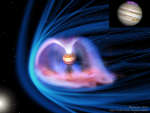 Auroras and the Magnetosphere of Jupiter
Auroras and the Magnetosphere of Jupiter
5.04.2016
Jupiter has auroras. Like near the Earth, the magnetic field of our Solar System's largest planet compresses when impacted by a gust of charged particles from the Sun. This magnetic compression funnels charged particles towards Jupiter's poles and down into the atmosphere.
 APOD: 2024 May 26 Б A Solar Filament Erupts
APOD: 2024 May 26 Б A Solar Filament Erupts
25.05.2024
What's happened to our Sun? Nothing very unusual -- it just threw a filament. Toward the middle of 2012, a long standing solar filament suddenly erupted into space, producing an energetic coronal mass ejection (CME).
 APOD: 2023 April 19 Б Auroral Storm over Lapland
APOD: 2023 April 19 Б Auroral Storm over Lapland
18.04.2023
On some nights the sky is the best show in town. On this night, auroras ruled the sky, and the geomagnetic storm that created this colorful sky show originated from an increasingly active Sun.
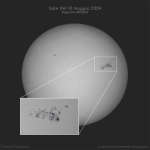 APOD: 2024 May 11 Б AR 3664: Giant Sunspot Group
APOD: 2024 May 11 Б AR 3664: Giant Sunspot Group
10.05.2024
Right now, one of the largest sunspot groups in recent history is crossing the Sun. Active Region 3664 is not only big -- it's violent, throwing off clouds of particles into the Solar System. Some of these CMEs are already impacting the Earth, and others might follow.
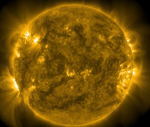 APOD: 2024 May 28 Б Solar X Flare as Famous Active Region Returns
APOD: 2024 May 28 Б Solar X Flare as Famous Active Region Returns
27.05.2024
It's back. The famous active region on the Sun that created auroras visible around the Earth earlier this month has survived its rotation around the far side of the Sun -- and returned. Yesterday...
|
January February March April May June July |
|||||||||||||||||||||||||||||||||||||||||||||||||